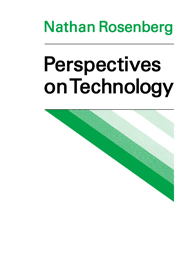Book contents
- Frontmatter
- Contents
- Acknowledgments
- Introduction
- Part 1 Some origins of American technology
- Part 2 The generation of new technologies
- Part 3 Diffusion and adaptation of technology
- 8 Capital goods, technology, and economic growt
- 9 Economic development and the transfer of technology: some historical perspectives
- 10 Selection and adaptation in the transfer of technology: steam and iron in America 1800-1870
- 11 Factors affecting the diffusion of technology
- Part 4 Natural resources, environment and the growth of knowledge
- Epilogue
- Notes
- Index
11 - Factors affecting the diffusion of technology
Published online by Cambridge University Press: 09 January 2010
- Frontmatter
- Contents
- Acknowledgments
- Introduction
- Part 1 Some origins of American technology
- Part 2 The generation of new technologies
- Part 3 Diffusion and adaptation of technology
- 8 Capital goods, technology, and economic growt
- 9 Economic development and the transfer of technology: some historical perspectives
- 10 Selection and adaptation in the transfer of technology: steam and iron in America 1800-1870
- 11 Factors affecting the diffusion of technology
- Part 4 Natural resources, environment and the growth of knowledge
- Epilogue
- Notes
- Index
Summary
The rate at which new techniques are adopted and incorporated into the productive process is, without doubt, one of the central questions of economic growth. New techniques exert their economic impact as a function of the rate at which they displace older techniques and the extent to which the new techniques are superior to the old ones. Although we are still a very long way from being able to assess the exact role of technological change – as distinct from all other factors – in generating the rise in resource productivity which is at the heart of the growth process, it is, I think, clear that the contribution of technological change itself will have to be established through the study of diffusion. Only in this way can we develop a closer understanding of the rate at which new techniques, once invented, have been translated into events of economic significance.
Although these remarks are, I believe, sufficiently uncontroversial, it is a striking historiographical fact that the serious study of the diffusion of new techniques is an activity no more than fifteen years old. Even today, if we focus upon the most critical events of the industrial revolution, such as the introduction of new techniques of power generation and the climactic events in metallurgy, our ignorance of the rate at which new techniques were adopted, and the factors accounting for these rates is, if not total, certainly no cause for professional self-congratulation.
- Type
- Chapter
- Information
- Perspectives on Technology , pp. 189 - 210Publisher: Cambridge University PressPrint publication year: 1976
- 5
- Cited by



